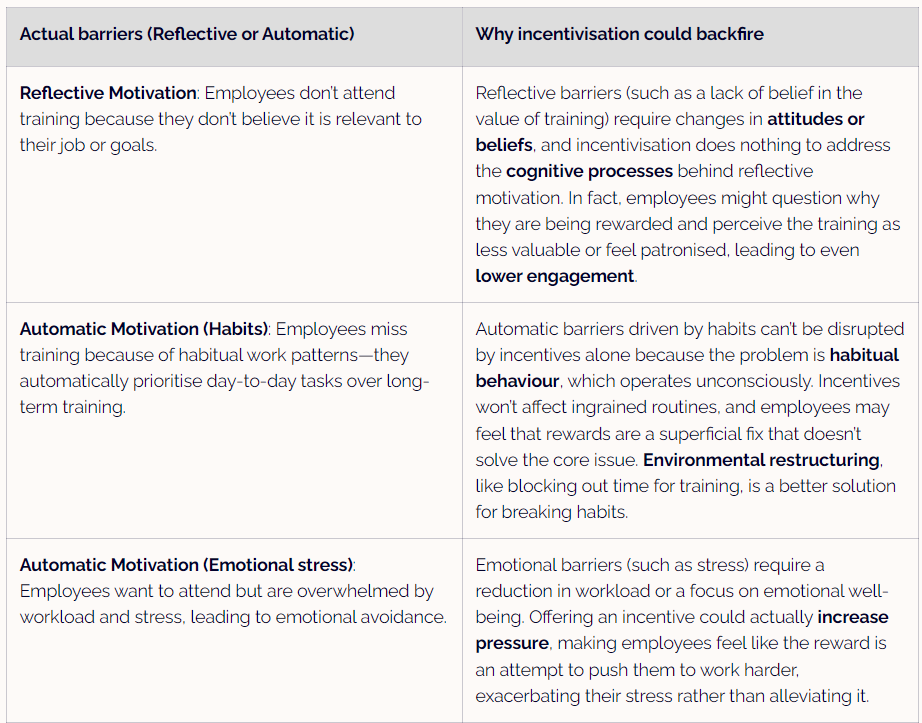Why misunderstanding motivation undermines behaviour change
Motivation drives everything we do—from hitting the snooze button to training for a marathon—yet understanding motivation isn't as straightforward as it may seem. For practitioners in the field of behaviour change, recognising that motivation operates on different levels is crucial because it can be the difference between designing an intervention that works and one that misses the mark.
In the Behaviour Change Wheel (BCW), motivation is split into two types: reflective and automatic. This distinction is not just theoretical but provides a practical framework for understanding whether a behaviour is driven by deliberate, conscious thought or by automatic processes like habits and emotional responses.
Getting this diagnosis right is essential for effective interventions. However, I’ve noticed confusion around this distinction, particularly how it translates into real-world interventions. In this article, I’ll unpack these concepts, highlight common pitfalls in understanding motivation, and explore how precision in identifying motivational barriers can lead to more impactful and sustainable behaviour change.
Defining reflective and automatic motivation
In the COM-B model, motivation is split into two categories: reflective and automatic. This separation helps diagnose behaviours more accurately and guides which intervention strategies are most likely to succeed. Let's take a closer look at each.
Motivation, as it's used in COM-B, is defined as "a mental process that energises and directs a behaviour" that includes thoughts, feelings, impulses and inhibitory processes that energise and direct a behaviour.
Reflective motivation refers to the realisation of evaluative beliefs or mental plans. It’s about the internal processes that drive behaviour based on judgments, evaluations, and intentions. For instance, reflective motivation comes into play when someone believes that running a 5k will improve their health, or when they judge that a plant-based diet will have long-term benefits. These beliefs, evaluations, and judgments influence the decision to act and help energise goal-driven behaviours. Reflective motivation is often easier to assess because it involves conscious reasoning, making it possible to ask individuals directly about their beliefs, goals, and expectations regarding their behaviour.
Automatic motivation, by contrast, involves impulses, inhibition of impulses, subjective wants, and needs. These processes typically operate below conscious awareness, often influencing behaviour through routine or emotional responses. For example, when someone reaches for a snack in response to stress or instinctively checks their phone out of boredom, automatic motivation is at work. These influences can be harder to detect because they are not driven by deliberate thinking and require more in-depth exploration to understand. Often, automatic motivation barriers arise from other sources—such as social norms or internal beliefs about personal capabilities, which can trigger emotional responses that influence behaviour unconsciously.
Here's a quick side by side comparison of Reflective and Automatic Motivation:

The importance of differentiating reflective and automatic motivation
Recognising the difference between reflective and automatic motivation is essential for designing effective behaviour change interventions. Each type drives behaviour in distinct ways and, crucially, responds to different strategies.
Reflective Motivation involves conscious processes like goals, beliefs, and evaluations, making it more direct to engage with. Interventions for reflective motivation often focus on education, planning, or reinforcing intentions. For example, helping someone increase their physical activity might involve supporting their belief that regular exercise improves health by providing information about its long-term benefits. Techniques such as setting goals, using reminders, or providing feedback on progress can strengthen reflective motivation.
Automatic Motivation, by contrast, operates unconsciously and is driven by habits, emotions, and impulses. Changing behaviours influenced by automatic motivation typically requires breaking habitual patterns or addressing emotional triggers. For instance, if someone has a habit of staying sedentary in the evenings, an intervention might focus on altering their environment—such as placing their workout gear in a visible spot—or creating a new routine to trigger physical activity automatically. Emotional triggers, like stress or fatigue, could also be managed by integrating relaxation techniques or scheduling lighter, more enjoyable exercises to fit with their mood.
By identifying which type of motivation is driving behaviour, we can tailor interventions to target the right processes. Aligning interventions with the correct motivational processes increases the likelihood of meaningful, sustained behaviour change.
Avoiding common pitfalls
In behaviour change interventions, misunderstanding the underlying motivation behind behaviour can lead to significant pitfalls. When we rely on oversimplified definitions of motivation or fail to distinguish between different types, we risk applying ineffective strategies, resulting in frustration or disengagement.
Three major pitfalls commonly arise:
Assuming a lay definition of motivation and over-relying on solutions like incentivisation without understanding the true barriers.
Failing to distinguish between reflective and automatic motivation, leading to mismatched interventions.
Overlooking the nuances within automatic motivation, where different subtypes—such as habitual behaviour and emotional responses—require distinct approaches.
We will explore each of these pitfalls in detail, starting with why motivation must be split into reflective and automatic, followed by an analysis of the differences within automatic motivation, and finally, how even when the correct strategy is chosen, it must be carefully tailored to the specific barrier.
Pitfall 1: Misdiagnosing motivation by assuming a lay definition
A common pitfall when addressing behaviour change is to assume a lay definition of motivation—asking whether someone is “motivated” in general terms without digging deeper. In this simplified view, motivation is often seen as a singular concept: either someone is motivated to do something, or they aren’t.
This oversimplified approach leads to the widespread use of interventions like incentivisation, which can seem like a logical solution when people appear unmotivated. By applying incentivisation based on a simplified understanding of motivation, we risk misdiagnosing the actual barriers and using the wrong strategy, which could backfire.
Assuming a lay definition of motivation and over-relying on incentivisation can lead to ineffective interventions. In COM-B, understanding whether the barrier is reflective or automatic helps tailor the intervention—whether it’s persuasion, environmental restructuring, or enablement—so that it actually addresses the root cause.
Pitfall 2: Failing to distinguish between Reflective and Automatic Motivation
The second pitfall arises when we don’t distinguish whether a behaviour is driven by reflective motivation or automatic motivation . This is critical because these two types of motivation require entirely different intervention strategies.
Misunderstanding whether a barrier is reflective or automatic can lead to ineffective strategies. For example, trying to persuade someone who is habitually distracted won’t work, just as restructuring the environment won’t address someone’s deeply held beliefs.
Pitfall 3: Overlooking nuances within Automatic Motivation
Even when we correctly identify a barrier as automatic motivation, there are still nuances within that type. For example, automatic behaviours can be driven by habits or by emotional responses such as stress. These two subtypes require very different approaches, even though both fall under the umbrella of automatic motivation.
Not all automatic motivation barriers are the same. If you apply habit-breaking techniques to someone whose real barrier is emotional stress, it could make the situation worse. The intervention needs to target the root of the issue—habitual behaviour or emotional overload—to be effective.
Why precision matters
Misunderstanding the motivational drivers behind behaviour leads to wasted effort, frustration, and disengagement. To avoid common pitfalls, it’s essential to:
Avoid assuming a lay definition of motivation and applying one-size-fits-all strategies like incentivisation without understanding the true barriers.
Distinguish between reflective and automatic motivation, ensuring interventions are matched to the type of motivation driving the behaviour.
Recognise the nuances within automatic motivation, and adjust interventions based on whether the barrier is driven by habitual behaviour or emotional stress.
Precision in diagnosing motivational barriers is the key to designing interventions that truly address the root causes of behaviour. Getting the details right at every stage ensures the strategy is effective, leading to lasting change and improved engagement.
Conclusion
Behaviour change interventions are more likely to succeed when they address the true barriers to behaviour. Misdiagnosing motivation leads to wasted effort and disengagement, but by distinguishing between reflective and automatic motivation, recognising nuances within automatic processes, and tailoring interventions accordingly, strategies can more effectively target the root causes.
While precision is important, behaviour change is rarely straightforward. Not every situation fits neatly into categories, and flexibility is often needed. Human behaviour is complex, and interventions may require a blend of strategies. The key is to stay adaptive, continually refining your approach based on the specific context.
What should I write about next?
I will potentially write similar articles for Capability and Opportunity, but given that Motivation is the most complex and nuanced of the three dimensions, there's plenty more to zoom in on. Tell me what you want to hear about next - I've listed some ideas below to vote on, but you can also drop me a note on LinkedIn.
How Motivation interacts with Capability & Opportunity: How motivation works alongside capability (psychological/physical) and opportunity (social/physical) in COM-B.
Conflicts between reflective and automatic motivation: What happens when conscious goals (reflective motivation) clash with habits or impulses (automatic motivation).
Motivation in long-term behaviour change: How motivation shifts over time and strategies for maintaining it in sustained behaviour change efforts.
Influence of Social Opportunity on Motivation: The impact of social norms and opportunities on both reflective and automatic motivation.
The role of feedback in motivation: How feedback can influence both reflective and automatic motivation, and how to tailor it for effectiveness.
Measuring or assessing motivation accurately: Tools and methods for diagnosing and measuring both reflective and automatic motivation.
In-depth analysis of Intervention Strategies: Exploring common intervention strategies (e.g., incentivisation, environmental restructuring, persuasion) and how they need to be adapted depending on the type of motivation.
How to Apply These Insights in Practice:: Practical tools and steps for practitioners to diagnose and address motivational barriers more effectively.
Comment below!






